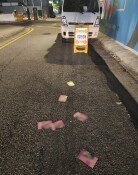Worst underground tunnel flooding accident occurred
Worst underground tunnel flooding accident occurred
Posted July. 17, 2023 08:07,
Updated July. 17, 2023 08:07
A record-high heavy downpour that hit the mid-southern region caused avalanche and stream flooding, claiming the lives of many people. Seventeen people were killed in the North Gyeongsang region alone, which suffered from avalanches. The Gungpyeong underground tunnel 2 at Cheongju, North Chungcheong was flooded by the nearby Miho River, claiming the lives of passengers in 10 cars. Despite the government’s determination to “make preparations to obsessive levels,” the heavy rain claimed many lives and assets.
The underground tunnel accident on Saturday morning shows how vulnerable underground areas are to floods. After the embankments near the Miho River broke down, the water spilled down like a waterfall into the tunnel, and it took less than five minutes for the 430-meter-long tunnel to be submerged entirely in water. Nine passengers failed to escape, including a newlywed man who was on his way to drop his brother-in-law off and a senior woman in her 70s on her way to work to clean.
What is more unfortunate is that there were several opportunities to prevent the accident. When streams grew to alarmingly high levels two hours and ten minutes before the tunnel became submerged, the Geumgang Flood Management Center asked the Heungdeok District Office of Cheongju to issue a warning to residents to restrict movement. Forty minutes before the accident occurred, the instructor at the construction inspection company that constricted the extension work of the Miho Stream bridge reported to the police, asking to restrict traffic due to the risk of flooding. The underground tunnel had a high risk of flooding as it was lower than other nearby rice paddies and farming areas. Why was traffic not restricted despite many warnings and reports?
The direct cause of the accident is the collapse of temporary endowments. However, residents pointed out that the endowments were not properly built, simply tacking sandbags on top and covering tarpaulin.
There were no facilities to automatically cut off water, and the drainage pump did not work either. Little has changed since the underground tunnel accident that occurred in 2020 when three people were killed. At that time, the government had promised to install facilities to automatically block water, which was scheduled to install at Gungpyeong underground tunnel in September. What is the reason for the delay despite the risk of flooding? Are the other 144 underground tunnels at risk of flooding across the nation safe?
It is very unfortunate to lose so many lives due to avalanches, despite the intensity of the heavy rainfall in a short amount of time. Yechon District of North Gyeongsang Province, which lost seven lives to avalanches, has been excluded from the avalanche-prone areas designated by the local district. Abnormal weather conditions make it difficult to rely on previous measures to prevent accidents. The Meteorological Office forecasted up to 300 millimeters of intensive rainfall in the central southern region by July 18. Government agencies should collaborate by information sharing to restrict traffic and ensure timely evacuation.




![반찬통 착색 고민 끝…‘두부용기’ 버리지 말고 이렇게 쓰세요 [알쓸톡]](https://dimg.donga.com/c/138/175/90/1/wps/NEWS/IMAGE/2026/01/09/133126593.3.png)


